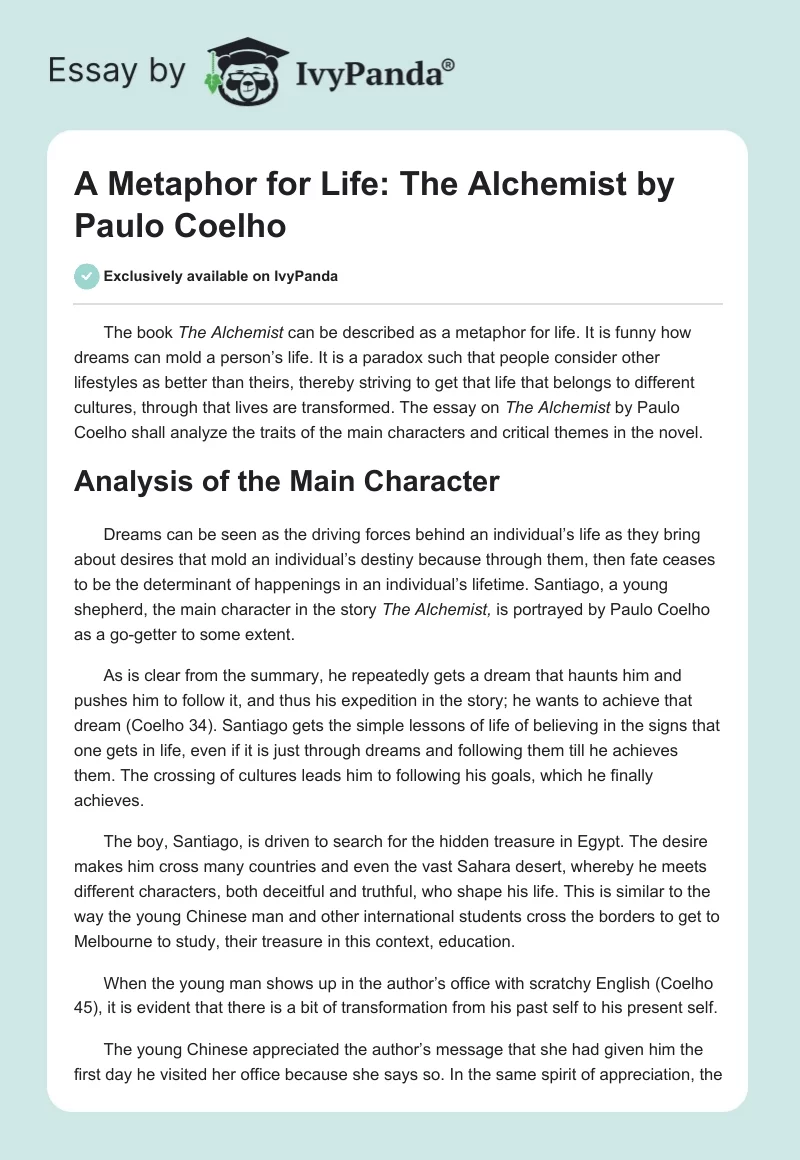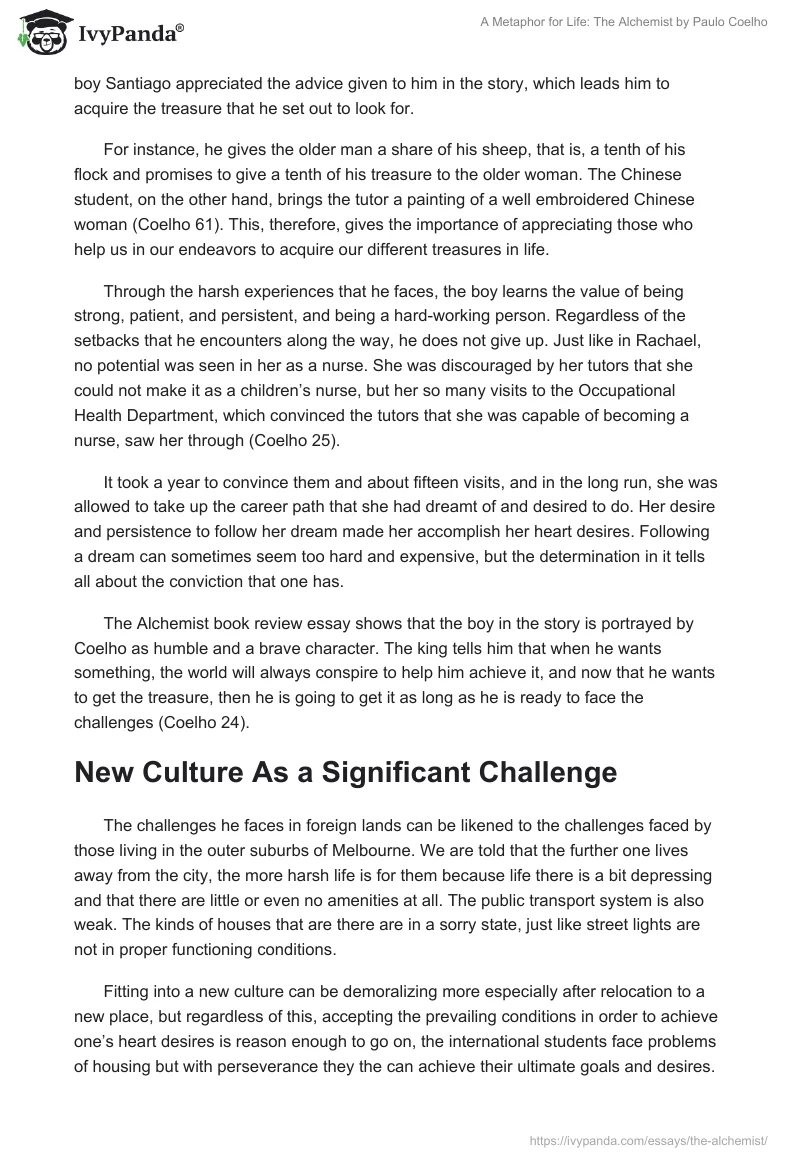The book The Alchemist can be described as a metaphor for life. It is funny how dreams can mold a person’s life. It is a paradox such that people consider other lifestyles as better than theirs, thereby striving to get that life that belongs to different cultures, through that lives are transformed. The essay on The Alchemist by Paulo Coelho shall analyze the traits of the main characters and critical themes in the novel.
Analysis of the Main Character
Dreams can be seen as the driving forces behind an individual’s life as they bring about desires that mold an individual’s destiny because through them, then fate ceases to be the determinant of happenings in an individual’s lifetime. Santiago, a young shepherd, the main character in the story The Alchemist, is portrayed by Paulo Coelho as a go-getter to some extent.
As is clear from the summary, he repeatedly gets a dream that haunts him and pushes him to follow it, and thus his expedition in the story; he wants to achieve that dream (Coelho 34). Santiago gets the simple lessons of life of believing in the signs that one gets in life, even if it is just through dreams and following them till he achieves them. The crossing of cultures leads him to following his goals, which he finally achieves.
The boy, Santiago, is driven to search for the hidden treasure in Egypt. The desire makes him cross many countries and even the vast Sahara desert, whereby he meets different characters, both deceitful and truthful, who shape his life. This is similar to the way the young Chinese man and other international students cross the borders to get to Melbourne to study, their treasure in this context, education.
When the young man shows up in the author’s office with scratchy English (Coelho 45), it is evident that there is a bit of transformation from his past self to his present self.
The young Chinese appreciated the author’s message that she had given him the first day he visited her office because she says so. In the same spirit of appreciation, the boy Santiago appreciated the advice given to him in the story, which leads him to acquire the treasure that he set out to look for.
For instance, he gives the older man a share of his sheep, that is, a tenth of his flock and promises to give a tenth of his treasure to the older woman. The Chinese student, on the other hand, brings the tutor a painting of a well embroidered Chinese woman (Coelho 61). This, therefore, gives the importance of appreciating those who help us in our endeavors to acquire our different treasures in life.
Through the harsh experiences that he faces, the boy learns the value of being strong, patient, and persistent, and being a hard-working person. Regardless of the setbacks that he encounters along the way, he does not give up. Just like in Rachael, no potential was seen in her as a nurse. She was discouraged by her tutors that she could not make it as a children’s nurse, but her so many visits to the Occupational Health Department, which convinced the tutors that she was capable of becoming a nurse, saw her through (Coelho 25).
It took a year to convince them and about fifteen visits, and in the long run, she was allowed to take up the career path that she had dreamt of and desired to do. Her desire and persistence to follow her dream made her accomplish her heart desires. Following a dream can sometimes seem too hard and expensive, but the determination in it tells all about the conviction that one has.
The Alchemist book review essay shows that the boy in the story is portrayed by Coelho as humble and a brave character. The king tells him that when he wants something, the world will always conspire to help him achieve it, and now that he wants to get the treasure, then he is going to get it as long as he is ready to face the challenges (Coelho 24).
New Culture As a Significant Challenge
The challenges he faces in foreign lands can be likened to the challenges faced by those living in the outer suburbs of Melbourne. We are told that the further one lives away from the city, the more harsh life is for them because life there is a bit depressing and that there are little or even no amenities at all. The public transport system is also weak. The kinds of houses that are there are in a sorry state, just like street lights are not in proper functioning conditions.
Fitting into a new culture can be demoralizing more especially after relocation to a new place, but regardless of this, accepting the prevailing conditions in order to achieve one’s heart desires is reason enough to go on, the international students face problems of housing but with perseverance they the can achieve their ultimate goals and desires.
The boy Santiago takes up every opportunity that comes his way, and he swallows through so many problems that he encounters along his path of getting to the treasure. He worked hard towards his destiny because no problem was too big for him to deal with.
We find that dreaming is one thing, and following that dream is another. Rachael had a dream of becoming a nurse, and she felt that she needed to give back to the community and serve the people who had made a significant difference in her life. That is why she really wanted to be a children’s nurse, she was laughed at told on several occasions that it was never going to happen because a nursing course was not suitable for her and that she was fit to a desk job (Coelho 25).
Nevertheless, as is evident from the assessment, her desire to follow her dream was the driving force that led her to achieving it in the long run. Had she given up along the way due to the words of discouragement from even her tutors, she could not have become a voice to reckon to the parents of the sick children that she attended to at the Children’s Out-patient Department (Coelho 25).
In the story, we are also brought to a level ground where freedom to choose what one wants to do should be embraced and given room to drive us. Freedom is the ability for one to do what he or she likes and that entails following one’s heart.
Through this, one is capable of exploiting his or her own potentialities and doing something that is self-fulfilling, if one is made to do something that dictates his or her destiny in a forceful way, then the end results will always be bitter. The boy chooses to travel the world because this is his inner calling other than studying theology and becoming a priest.
He enjoys the life of adventure and traveling to new places. On her part, Rachael could have been forced to do a desk job because of her health, something that she could have done regretfully, thereby ending up a slave in a career path that on the contrary, should have brought her inner peace and happiness. The boy was allowed to follow his heart, which led him later on to acquire his life experiences that are worthwhile, even more than he could have achieved material treasures.Thus, with the help of vast imagery, symbolism, and paradoxes in The Alchemist, the author shows us the full circle of the story.
Coelho’s Attitude to the Main Theme
The challenges faced by adapting to a new culture can sometimes be too much to bear, but how ready is a person to bear with the challenges that come with it? At the same time, it can be hard to make a dream a reality, but how persistent that can one be to catch up with that dream (Coelho 89)? Both parties, therefore, should equip themselves with the communication gear, which most definitely is the vehicle that will enable one to get to his or her destiny.
The individual will get room to express him/herself, thereby appreciating each other as well as compromising with each other’s feelings where possible, that way the joy of learning will have come into play. Once a dream has been hatched, then the determination and persistence that will be employed in making it a reality is what will determine whether it is going to be the destiny of an individual, and that is what brings in the difference between destiny and fate.
Though not sure of his destiny, he strives to get it no matter the challenges, and his life experiences show that everyone needs to work hard to achieve success, one needs to strive for the good things in life. This simply inspires people to put effort in order to achieve our goals, for one to make his or her dreams become a reality, he or she is not just going to sit there and wait for dreams to fall into place, one needs to risk the good things in life in order to achieve better ones (Coelho 100).
Conclusion
As is clear from the essay on The Alchemist, Coelho simply intends to bring to our attention that if one dreams and wishes for something then one should be persistent about it and be patient for long enough, one might lose an opportunity by getting tired at the last minute and give up so quickly, and see the fruits after somebody else has achieved the fruits of our long-suffering. Just like Santiago, one’s wishes can come in both material objects and life experiences, as for the case of Santiago, his journey to the Pyramids in Egypt, is his treasure.
Works Cited
Coelho, Paulo. The Alchemist. New York. Harpertorch. 1993. pp. 1 – 163.


